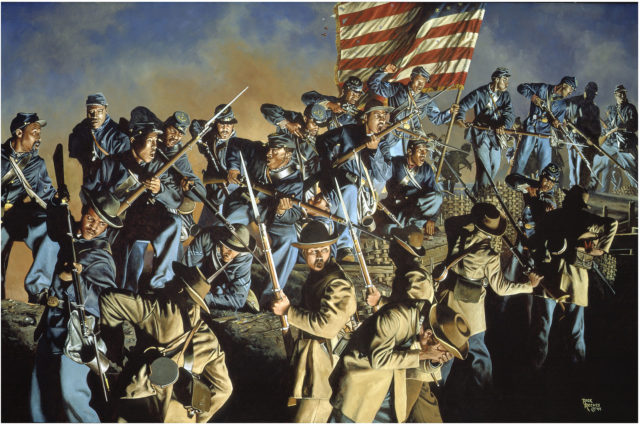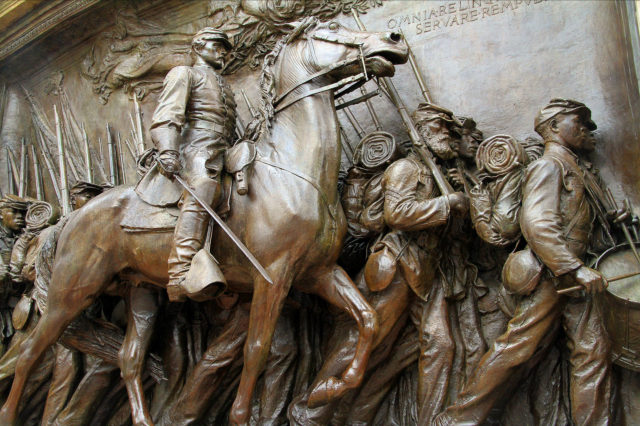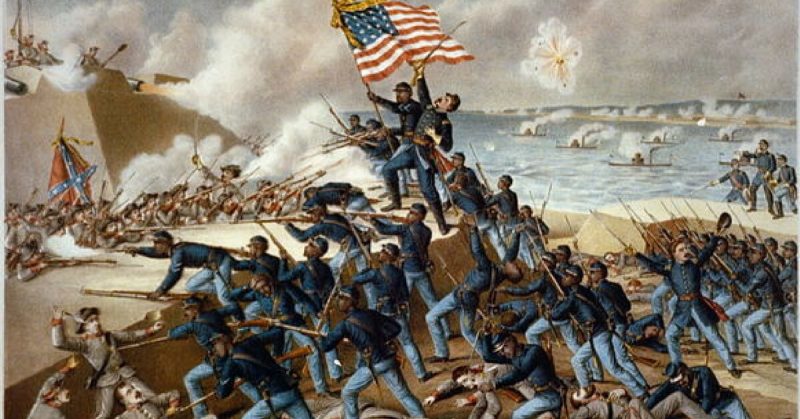Edward Zwick’s film Glory is one of the best-known screen depictions of the American Civil War. It is the story of the 54th Massachusetts Regiment, one of the first African-American units, from its creation to its first major action. The film won three Oscars, including Denzel Washington for best-supporting actor.
How accurately does the film depict the war and the story of the 54th Massachusetts?
Responses to the Regiment
The 54th Massachusetts was not the first African-American unit to serve the Union. Nevertheless, it was a bold experiment, as the film depicts.
The other units had been raised quietly and used in obscurity, to test how they performed and how people reacted. However, although some of them were praised for their battlefield performance in May and June 1863, they remained in the background. The film overlooks their existence.
The emphasis on the 54th Massachusetts Regiment’s importance is accurate. Raised by Governor Andrew of that state, they were the first widely publicized African-American unit.
Responses to the unit’s existence were as mixed as the film shows. Abolitionists were pleased. Others were appalled. Specific incidents of racism by officers were invented for the movie, but the overall tone is correct. There was no question of making African-Americans into officers, and their white officers faced stigma for serving in the unit.

If anything, racial prejudice in the Union is understated. Democrat politicians had stirred up racism for their own ends. In July 1863, African-Americans were beaten and killed during four days of draft riots in New York.
Robert Gould Shaw
The film’s leading character, Robert Gould Shaw, was the unit’s first commander in real life. As Glory shows, he was a privileged son of New England gentry and an ardent abolitionist. When he was given his command, he was already a veteran of the war.
However, the film misses an opportunity in Shaw’s recruitment. He is shown receiving his invitation to command at a fancy dinner party and instantly accepting the offer. In reality, Shaw was with his regiment when his father brought the letter from Governor Andrew. He struggled to decide whether to accept the offer, initially rejecting it. It was a crucial few days for the young man.
For the most part, Shaw has been portrayed accurately. His commitment to the unit and abolition were real, as was his hard work in shaping the regiment and his death alongside them.
Other Soldiers
In dramatizing the issues of the American Civil War, Glory implies that the 54th Massachusetts Regiment was made up mostly of former slaves. In reality, most of the men in the unit had been free their entire lives. They were northerners fighting for the north as well as African-Americans fighting for African-Americans. Some of them came from prominent families.
Specific characters in Glory’s 54th are mostly fictional. Shaw’s childhood friend reduced to serving under him and his second in command are both dramatically useful figures, but neither man was real. The brash rebel played by Denzel Washington and the wise older man played by Morgan Freeman are both made up.
The real men who fought in the regiment did not dramatize the oppression of the period as clearly. Two sons of Frederick Douglas signed up straight away, one of them becoming the regimental sergeant major. Garth Wilkinson James, the brother of William and Henry James, was fatally injured serving as an adjutant during the assault on Fort Wagner. Robert Simmons, a sergeant, lost a nephew in the draft riots three days before he was fatally wounded in combat.
There is a more complex story to be told about those men and their place in American society. They were more privileged than most African-Americans but still faced enormous prejudice. It is a story the film could not have explored in its short time while retaining Glory’s central theme. Perhaps in the golden age of TV dramas, their tale will be told.
Symbolic Moments
Two powerful symbolic moments show the film’s complicated relationship with the truth.
Shaw’s attack on a row of watermelons during training symbolizes the hard work of preparing for war. Its overall message about prejudice and Shaw’s dedication captures the truth. However, the unit trained in Massachusetts from February to May; watermelons would have been in short supply.
The regiment’s refusal to accept lower pay was real. It started a campaign which shamed Congress into giving African-American soldiers the same pay as whites. Shaw, rather than the fictional Private Trip, encouraged the soldiers not to accept lower pay; which is possibly an unimportant detail.

Fort Wagner
The climax of the film, the 54th Massachusetts Regiment’s assault on Fort Wagner, is among the most realistic depictions of American Civil War combat. The suicidal experience of charging into a hail of shells and musketry is depicted well. The equipment used and their participation in the war are shown in realistic detail.
In broad terms, the events of the attack are also accurate. The 54th were forced to advance down a narrow strip of beach between the ocean and swamps. The geography of the film’s location means a careful viewer can see they are advancing south which is a reversal of reality, across an otherwise realistic terrain. The dusk timing of the attack is accurate rather than embellishment, history helping the filmmakers.
The outcome and aftermath are also sadly realistic. The assault was a failure. Many men of the 54th were killed, Shaw among them. The Confederates buried them in an unmarked grave, including Shaw. It was intended as an insult, but his father believed it was the most fitting resting place his son could have.
As Good as Historical Films Get
No historical film perfectly captures every detail. Some things are unknown, others are uncertain, and liberties are taken both for the practicalities of film-making and to show broader truths.
Glory takes some such liberties, but far fewer than most historical epics. It accurately depicts the story of a unit, its commander, and their importance in American history.
Source:
James M. McPherson (1996), Drawn With the Sword: Reflections on the American Civil War
